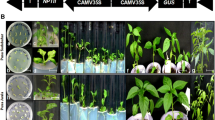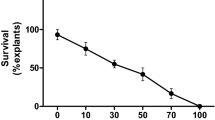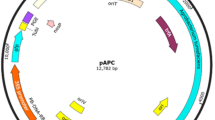Abstract
The technologies allowing the production of transgenic plants without selectable marker genes, is of great interest in public and environmental safety. For generating such marker-free transgenic plants, possibility has been offered by Multi-Auto-Transformation [MAT] vector system, which combines positive selection, using the isopentenyl transferase (ipt) gene, with a site-specific recombination that generates marker-free plants. In this study Agrobacterium tumefaciens strain EHA105 harboring an ipt-type MAT vector, pMAT21, containing lacZ, gus genes and the removable cassette in the T-DNA region was used to produce marker-free transgenic Kalanchoe blossfeldiana Poelln., employing ipt gene as the selectable marker gene. Co-cultivated explants were cultured on hormone- and selective agent-free MS medium, and 85% of the regenerated shoots showed ipt-shooty phenotype with GUS expression. Forty-one morphologically normal shoots were produced during the subculture. More than ninety percent of the normal shoots were ipt −, gus − but lacZ + as determined by PCR analyses. These results indicate that the ipt phenotype was clearly distinguishable from non-transgenic as well as transgenic marker-free shoots. This study opens interesting perspective for the generation of marker-free transgenic K. blossfeldiana with objective useful transgene.



Similar content being viewed by others
Abbreviations
- IPT:
-
Isopentenyl transferase gene
- GUS:
-
β-Glucuronidase
- MS medium:
-
Murashige and skoog medium
References
Aida R, Shibata M (2002) High frequency of polyploidization in regenerated plants of Kalanchoe blossfeldiana cultivar ‘Tetra Vulcan’. Plant Biotechnol 19:329–334
Akiyoshi DE, Klee H, Amasino RM, Nester EW, Gordon MP (1984) T-DNA of Agrobacterium tumefaciens encodes an enzyme of cytokinin biosynthesis. Proc Natl Acad Sci USA 81:5994–5998. doi:10.1073/pnas.81.19.5994
Barry GF, Rogers SG, Fraley RT, Brand L (1984) Identification of a cloned cytokinin biosynthetic gene. Proc Natl Acad Sci USA 81:4776–4780. doi:10.1073/pnas.81.15.4776
Craig NL (1988) The mechanism of conservative site-specific recombination. Annu Rev Genet 22:77–105. doi:10.1146/annurev.ge.22.120188.000453
Dale EC, Ow DW (1990) Intra- and intermolecular site-specific recombination in plant cells mediated by bacteriophage P1 recombinase. Gene 91:79–85. doi:10.1016/0378-1119(90)90165-N
Descoings B (2003) Kalanchoe. In: Eggli U, Hattmann HEK (eds) Illustrated handbook of succulent plants Crassulaceae. Springer, New York, pp 143–181
Ditta G, Stanfield S, Corbin D, Helinski DR (1980) Broad host range cloning system for gram negative bacteria: constuction of gene bank of Rhizobium meliloti. Proc Natl Acad Sci USA 77:7351–7374. doi:10.1073/pnas.77.12.7347
Ebinuma H, Komamine A (2001) MAT (multi-auto-transformation) vector system. The oncogenes of Agrobacterium as positive markers for regeneration and selection of marker-free transgenic plants. In Vitro Cell Dev Plant 37:103–113
Ebinuma H, Sugita K, Matsunaga E, Yamakado M (1997) Selection of marker-free transgenic plants using the isopentenyl transferase gene as a selectable marker. Proc Natl Acad Sci USA 94:2117–2121. doi:10.1073/pnas.94.6.2117
Endo S, Kasahara T, Sugita K, Matsunaga E (2001) The isopentenyl transferase gene is effective as a selectable marker gene for plant transformation in tobacco (Nicotiana tabacum cv. Petite Havana SR1). Plant Cell Rep 20:60–66. doi:10.1007/s002990000279
Horsch RB, Fry JE, Hoffman NL, Eichhholtz D, Rogers SG, Fraley RT (1985) A simple and general method for transferring genes into plants. Science 227:1229–1231. doi:10.1126/science.227.4691.1229
Izumikawa Y, Takei S, Nakamura I, Mii M (2008) Production and characterization of inter sectional hybrids between Kalanchoe spathulata and K. laxiXora( = Bryophyllum crenatum). Euphytica 163:123–130. doi:10.1007/s10681-007-9619-8
Jefferson RA (1987) Assaying chimeric genes in plants: the GUS gene fusion system. Plant Mol Biol Rep 5:387–405. doi:10.1007/BF02667740
John MC, Amasino RM (1989) Extensive change in DNA methylation patterns accompanies activation of a silent T-DNA ipt gene in Agrobacterium tumefaciens-transformed plant cells. Mol Cell Biol 9:4298–4303
Khan RS, Chin DP, Nakamura I, Mii M (2006) Production of marker-free transgenic Nierembergia caerulea using MAT vector system. Plant Cell Rep 25:914–919. doi:10.1007/s00299-006-0125-6
Lloyd AM, Davis RW (1994) Functional expression of the yeast FLP/FRT site-specific recombination system in Nicotiana tabacum. Mol Gen Genet 242:653–657. doi:10.1007/BF00283419
Maeser S, Kahmann R (1991) The Gin recombinase of Mu can catalyse site-specific recombination in plant protoplasts. Mol Gen Genet 230:170–176. doi:10.1007/BF00290665
Matzke MA, Matzke AJM, Scheid OM (1994) Inactivation of repeated genes—DNA–DNA interaction? In: Paszkowski J (ed) Homologous recombination and gene silencing in plants. Kluwer, Dordrecht, pp 271–307
Mette MF, van der Winden J, Matzke MA, Matzke AJM (1999) Production of aberrant promoter transcripts contributes to methylation and silencing of unlinked homologous promoters in trans. EMBO J 18:241–248. doi:10.1093/emboj/18.1.241
Mette MF, Aufsat ZW, van der Winden J, Matzke MA, Matzke AJM (2000) Transcriptional silencing and promoter methylation triggered by double-stranded RNA. EMBO J 19:5194–5201. doi:10.1093/emboj/19.19.5194
Murashige T, Skoog F (1962) A revised medium for rapid growth and bioassays with tobacco tissue cultures. Physiol Plant 15:473–497. doi:10.1111/j.1399-3054.1962.tb08052.x
Ogawa Y, Mii M (2004) Screening for highly active β-lactam antibiotics against Agrobacterium tumefaciens. Arch Microbiol 181:331–336. doi:10.1007/s00203-004-0650-z
Onouchi H, Yokoi K, Machida C, Matsuzaki H, Oshima Y, Matsuoka K, Nakamura K, Machida Y (1991) Operation of an efficient site-specific recombination system of Zygosaccharomyces rouxii in tobacco cells. Nucleic Acids Res 19:6373–6378. doi:10.1093/nar/19.23.6373
Onouchi H, Nishihama R, Kudo M, Machida Y, Machida C (1995) Visualization of site-specific recombination catalyzed by a recombinase from Zygosaccharomyces rouxii in Arabidopsis thaliana. Mol Gen Genet 247:653–660. doi:10.1007/BF00290396
Rogers OS, Bendich JA (1988) Extraction of DNA from plant tissues. In: Gelvin SB, Schilperoort RA, Verma DPS (eds) Plant molecular biology manual, vol A6. Kluwer, Dordrecht, pp 1–10
Russell SH, Hoopes JL, Odell JT (1992) Directed excision of a transgene from the plant genome. Mol Gen Genet 234:49–59
Sugita K, Matsunaga E, Ebinuma H (1999) Effective selection system for generating marker-free transgenic plants independent of sexual crossing. Plant Cell Rep 18:941–947. doi:10.1007/s002990050688
Acknowledgment
The authors would like to thank Dr. H. Ebinuma, Pulp and Paper Research, Nippon Paper Industries, Tokyo for providing the MAT vector construct.
Author information
Authors and Affiliations
Corresponding author
Rights and permissions
About this article
Cite this article
Thirukkumaran, G., Khan, R.S., Chin, D.P. et al. Isopentenyl transferase gene expression offers the positive selection of marker-free transgenic plant of Kalanchoe blossfeldiana . Plant Cell Tiss Organ Cult 97, 237–242 (2009). https://doi.org/10.1007/s11240-009-9519-9
Received:
Accepted:
Published:
Issue Date:
DOI: https://doi.org/10.1007/s11240-009-9519-9




